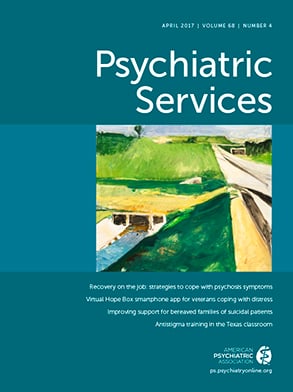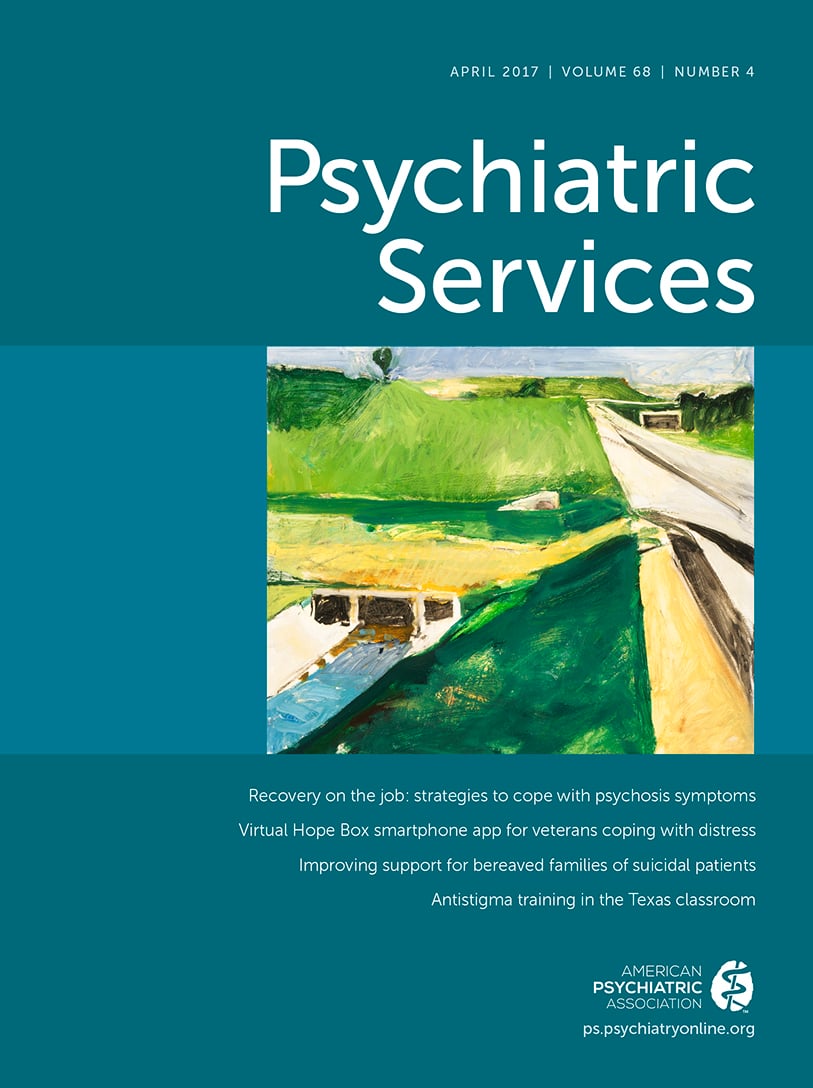Coordinated specialty care (CSC) is a multidisciplinary team approach for delivering evidence-based, early intervention services to young people experiencing first-episode psychosis (FEP) to improve outcomes (
1). OnTrackNY is a CSC program in New York State that provides treatment to individuals ages 16 to 30 who have experienced nonaffective psychosis for less than two years. The program helps young people achieve their goals for school, work, and social relationships. Resources developed for OnTrackNY are available on the program’s Web site (
http://ontrackny.org/Training).
The CSC model grew from the Recovery After an Initial Schizophrenia Episode (RAISE) projects, funded by the National Institute of Mental Health (NIMH). Launched in 2008, RAISE aimed to develop and test a treatment model to reduce relapse and long-term disability. NIMH required that the model be ready for rapid deployment if found effective (
2). Two RAISE studies, the RAISE Early Treatment Program (ETP) and the RAISE Implementation and Evaluation Study (RAISE-IES), laid the groundwork for larger-scale implementation (
2,
3). The RAISE-IES Connection Program involved two sites (Baltimore and New York City), with 65 enrollees in a treatment program that provided medication, supported employment and education, family support and education, psychoeducation, skills training, substance abuse treatment, and suicide prevention as part of an implementation feasibility study (no comparison condition). Clients had high rates of engagement, and, overall, clients showed significant improvement in symptoms and functional outcomes (
2). In the RAISE-ETP trial, 34 clinics in 21 states were randomly assigned to provide CSC services called NAVIGATE or usual community-based care. Overall, individuals who received NAVIGATE services had significantly better rates of engagement, improved quality of life, and reduced symptoms (
3). Both RAISE programs promoted recovery-oriented principles of care, including shared decision making (SDM) and an emphasis on minimizing disability.
Encouraged by the early success of the RAISE Connection Program (
2) and committed to an early intervention approach, the New York State Office of Mental Health (OMH) earmarked state funds to expand FEP services. The office of the OMH chief medical officer had overall responsibility. The Center for Practice Innovations (CPI), an OMH-funded training and technical assistance center at the New York State Psychiatric Institute, was charged with program development, implementation, training, and monitoring.
The RAISE Connection Program completed its research in June 2013. At that time, the RAISE-ETP study was still under way and other FEP programs, such as the Early Assessment and Support Alliance in Oregon and Specialized Treatment Early in Psychosis in Connecticut were becoming better known. CPI solicited feedback and review of Connection Program materials from leaders in the field before modifying the model. The Center for Social Innovation was engaged to help brand the program, which was named OnTrackNY to epitomize its positive and hopeful mission. OnTrackNY leadership presumed that although the RAISE studies were positive, the evidence base had significant limitations and the model would evolve and encompass best practices in response to emerging science and local experience and adaptation. The transition from RAISE Connection to OnTrackNY occurred in June 2013 with the initial funding of four teams.
In 2014, U.S. House of Representatives bill 3547 provided an increase of 5% to the Community Mental Health Block Grant program, an allocation targeted at evidence-based programs for early psychosis. The funds were maintained in 2015 and doubled in 2016. This funding and the state’s commitment to make FEP services widely available contributed to the addition of OnTrackNY teams throughout the state.
The OnTrackNY Model
An OnTrackNY team requires four full-time-equivalents (FTEs): two FTE positions are staffed by licensed clinicians to fulfill the roles of the primary clinician, outreach and recruitment coordinator, and team leader (who must be full-time on the team); one full-time supported education and employment specialist; a half-time peer specialist; and a part-time prescriber and nurse. Each team serves between 35 and 45 individuals, depending on staffing, and provides a range of evidence-based treatments, which are described below.
Evidence-based psychopharmacology involves prescribing the lowest effective doses of antipsychotics with the fewest side effects. An emphasis on health and wellness/primary care coordination addresses cardiometabolic factors associated with antipsychotics by providing education on nutrition and exercise, assessing health with routine lab work, and coordinating with other medical professionals. Case management helps individuals and families meet concrete needs (such as health insurance and housing) and connects individuals to outside resources. Cognitive-behavioral–based therapy includes two components. The first is a general supportive approach focusing on engagement and collaborative identification of personal goals. The second focuses on cognitive-behavioral principles to treat symptoms of psychosis and related conditions (such as substance use and trauma). The overarching focus is training in resiliency, illness and wellness management, and coping skills. The delivery of psychotherapy is flexible (for example, provided in groups or individually, in the clinic, or in the community), and the content discussed in sessions is tailored to individual needs and preferences.
Through family support and education, the team strives to provide the right level of family involvement in all aspects of treatment, consistent with client and family preferences. Clinicians encourage family involvement in treatment planning and ongoing care and assist family members to forge a collaborative relationship with all team members. Families are also offered more formal services, including psychoeducation and consultation. Because young adults almost always have work- and school-related goals, teams include supported education and employment specialists who use the individual placement and support model, expanded to include education. This consists of assessing work and school interests and needs, facilitating rapid placement in the desired work or school setting, and providing follow-up supports as needed.
Peer services were recently added to the model. The peer specialist focuses on building a relationship with participants, enhancing outreach efforts to help them stay connected to the program, connecting them to resources in the community, and empowering them to advocate for themselves and effectively use OnTrackNY services.
OnTrackNY treatment is delivered in a person-centered, recovery-focused, culturally competent fashion and uses an SDM framework (
4). The team strives to convey hope for recovery and views the client as the central team member. The client’s life goals, aspirations, and ambitions drive treatment planning; no treatment component is mandatory. SDM is a collaborative process that provides specific steps for clients and providers to make health care decisions together. SDM provides a framework of empowerment for clients. Patricia Deegan, Ph.D., helped create the program’s SDM materials.
Training and Implementation
Training consists of a flexible strategy delivered by a centralized team. A three-day, in-person training introduces providers to the model. Technical assistance continues through individual and collaborative role-based calls, care consultation calls, and special topics requested by trainees. CPI has an online learning management system (LMS) that provides access to training modules, event registration, and resource libraries and allows tracking of participants’ module completion, training attendance, and training evaluations. Several levels of evaluation are collected: satisfaction with and usefulness of training, knowledge mastery, self-efficacy, and reports of practice change as a result of training. The LMS also allows team leaders to assign training and obtain real-time reports of staff completion.
Teams identify special topics for additional training. Case identification can be difficult given the low incidence of FEP and the challenge of accurately assessing symptom onset to determine eligibility. Clinicians requested additional training in how to differentiate FEP from other mental illnesses. With regard to suicide prevention, clinicians felt adept at screening for suicidality and implementing a safety plan. However, they asked for assistance in developing a more systematic approach to assessing suicide risk and weighing risk and protective factors. This is particularly necessary when participants deny suicidal ideation and yet engage in impulsive or dangerous behaviors. Teams also sought more guidance on assessing risk of violence and aggression and learning strategies for addressing these issues. Teams provide services to individuals and families with a wide variety of cultural beliefs and identities associated with their race-ethnicity, religion, language, socioeconomic status, gender, sexuality, and youth culture. Therefore, it became important to enhance the teams’ cultural competency. Finally, prescribers requested support for using long-acting injectable medications and clozapine.
For all these topics, the training team developed enhanced activities and materials that allowed for more in-depth discussion, extensive use of case examples, and identification of validated assessment tools and consulted the scientific literature to inform service delivery. Outside experts in each area delivered technical assistance to the teams. Cultural competency and gender and sexuality experts were enlisted to develop training materials. With team input, we are developing a guide on culture and FEP. We are also creating a set of Web-based modules to provide psychoeducation about LGBTQ populations and strategies for working with related issues among young people experiencing FEP.
Demographic Characteristics, Referral Sources, Engagement, and Fidelity Data
As a condition of funding, teams submit client- and team-level data regarding key service components and client outcomes as measures of fidelity on a monthly basis to OMH and receive monthly continuous quality improvement–focused reports from the CPI training team. The program has established basic performance expectations, which are being developed into a full fidelity protocol.
As of September 2016, 13 OnTrackNY programs are operating, with eight more programs slated to open by the end of 2016. OnTrackNY enrolled its first new client in October 2013. We began tracking referral sources in July 2015. Roughly 40% of referrals have come from inpatient psychiatric units and about 20% from both outpatient mental health settings and self or family referrals. Others have come from school systems, community organizations, and emergency departments. We have tracked client characteristics and outcomes since 2013. As of July 2016, a total of 386 clients have been enrolled, with a mean±SD age of 21.0±3.3. Sixteen percent of clients are under age 18; 70% are male, and just over 40% are white, 39% are black, and 22% identify as Hispanic. The insurance mix is 51% public and 40% private, and the rest have other types of insurance or are uninsured.
For the 365 clients with baseline data, the mean time since onset of psychosis to enrollment in OnTrackNY was 7.2±5.9 months (range 4.3–15.6 months). Engagement (defined as continued enrollment and at least one visit in the past three months) in OnTrackNY services has been high from the beginning, averaging 99% at three months and 82% at 12 months. Measured outcomes, such as rates of hospitalization and enrollment in school and employment, have been promising. Among the 238 clients with at least two follow-up data points, 73% had at least one hospitalization at baseline. This decreased to 14% at the first three-month follow-up and 11% within three months of the last or most recent follow-up. At baseline, 45% of clients were enrolled in school or employed, which increased to 65% at the first follow-up and 74% at the last or most recent follow-up.
Conclusions
CSC services are being implemented across the country, and it has become evident that there are significant differences across states related to population density and incidence of FEP, available workforce, involvement of state-level leadership and coordination of efforts, and financial circumstances. Given the gaps in research on early intervention services for FEP, we hope that as CSC expands, the treatment model will continue to evolve on the basis of scientific evidence of best practices and also through enhanced understanding of local experiences. Central issues regarding program promulgation are related to whether the gains experienced by individuals in CSC programs can be sustained after treatment ends and whether other models can accrue similar benefits. Many questions remain regarding ongoing financial support of OnTrackNY teams, and CPI continues to work with OMH to develop reimbursement guidance for Medicaid and commercial insurance.

